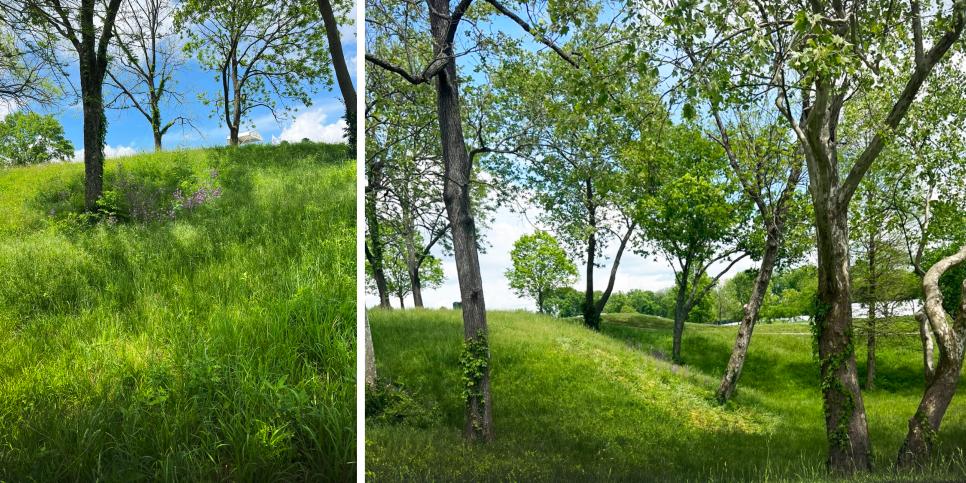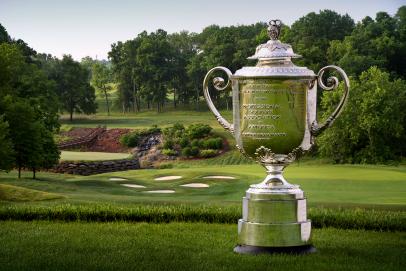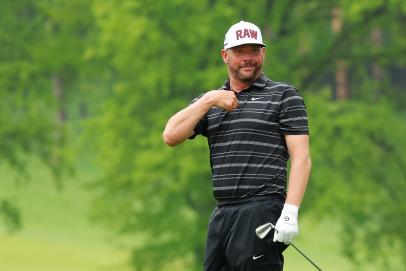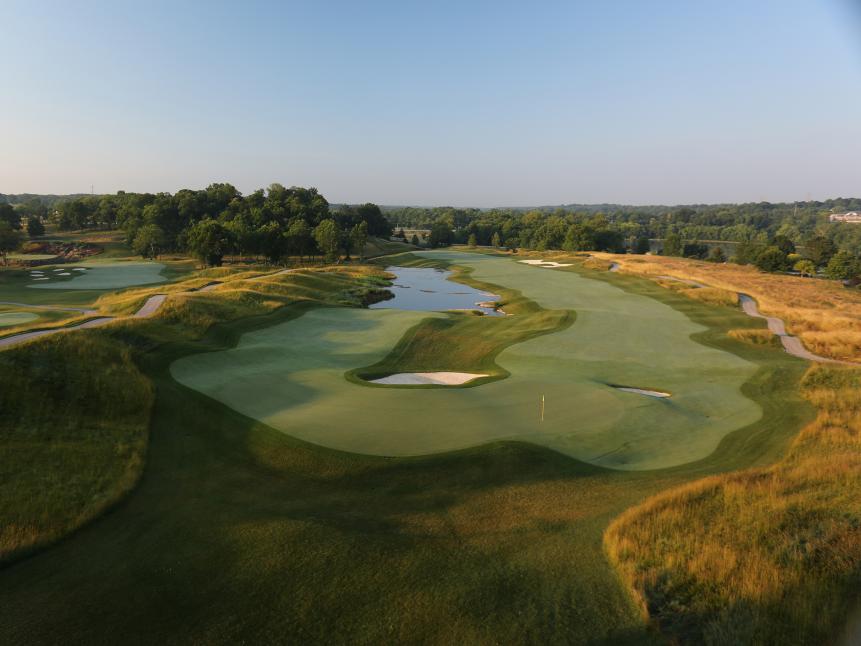Urban legends are a barstool currency, traded among sports fans to inform and debate but mostly to entertain. Many of them are surreptitious in nature and border on the apocryphal, such as Michael Jordan’s really retiring from basketball because of a gambling suspension, Cassius Clay’s phantom punch of Sonny Liston, and the 1985 NBA Draft’s “frozen envelope.” Yet enough of them have turned out to be true—such as the tale of Wade Boggs drinking 70 beers on a single cross-country flight, then going 2-for-3 the next day, or the 1951 New York Giants using a telescope to steal signs en route to the World Series—to confer a veil of possibility to every folklore.
Besides, the sports world provides daily examples of its ridiculousness; these stories are merely extensions of a reality we already know.
One of golf’s spiciest urban legends? That Tiger Woods’ 2000 PGA Championship win over Bob May was saved by a spectator kicking his errant drive at the final playoff hole out of fescue.
It is a narrative originally spurred by television. CBS Sports’ broadcast caught Woods’ drive on the third hole of a three-hole playoff (the par-5 18th) as it was falling out of the sky, only to briefly lose sight of the ball as it neared a grove of trees and heather. After a couple of seconds, the ball reappears, seemingly going the other direction from where it landed with massive amounts of speed.
The optics were suspicious, and were noted by CBS’ play-by-play announcer Jim Nantz and lead analyst Ken Venturi:
Venturi: “What happened with that ball?”Nantz: “Do you think someone either kicked it or threw it back in that direction?”Venturi: “I don’t know. It, it didn’t …”Nantz: “It didn’t react naturally, did it?”Venturi: “No, it didn’t at all.”Nantz: “I sure hope someone didn’t slap it back.”Venturi: “It could have been someone jumped up and hit it with their hand.”
Neither Nantz nor Venturi were positive at what happened, and there was no further video evidence that was shown on the telecast. Woods, holding a one-stroke advantage into the final playoff hole, was able to hit his second shot back into play, then got up-and-down out of a greenside bunker as May’s birdie putt just came up short. Woods won his second Wanamaker Trophy and his third straight major win en route to winning the “Tiger Slam.”
The primary suspect of potential malfeasance appears to be a man in a white shirt who’s chasing after the ball. He is seen heading in the ball’s apparent direction, and once he disappears the ball returns on video. However, his arms are also extended like a baseball umpire signaling “safe,” possibly to keep other fans away to make sure no one interferes with a still-moving ball. Another fan just to the left, dressed in a black hat, white shirt and khaki pants, is seen pointing in the direction of the ball, seemingly tracing its journey as the ball bounces down the path, and he doesn’t appear to gesture like any misconduct occurred. Or is he pointing because he just saw the man in white kick the ball, possibly by accident, down the hill? Other spectators seen on video don’t indicate anything afoul has happened, but golf crowds—especially major championship crowds—are often filled with people who aren’t hardcore or even casual fans. To them, a kicked ball might not warrant a second glance.
Because the video doesn’t show anything definitively, it opens the door for any and all possibilities. It is golf’s sanitized version of President John F. Kennedy’s assassination, and like JFK conspiracy theories, Valhalla’s involves a grassy knoll, a pellet magically turning back and to the left, and a possibly unseen second shooter (er, kicker). But the truth is out there, and with the PGA returning to Louisville, we tried to discover what actually happened with Tiger’s lucky bounce.
RELATED: The five holes that will decide the PGA
We initially sought the help of forensic video consultants to decipher what happened in the video, and many of these analysts responded that this exercise would be a colossal waste of their time and expertise. One analyst, a cinematographer named Dan Voshart, was game, and laid out a plan for deciphering what happened to Woods’ ball when it landed.
Private Valhalla Golf Club Louisville, KY 4.6 102 Panelists
- 100 Greatest
- Best In State
Given a difficult piece of land on which to create Valhalla (half the site was floodplain, with high-tension power poles), Jack Nicklaus drew on his training under Pete Dye and Desmond Muirhead to produce a unique design, with an alternate fairway par 5, a par 4 with an island green and an 18th green shaped like a horseshoe. Over the decades, Nicklaus returned periodically to update its challenges, and the club rebuilt bunkers and replaced its soft bent grass fairways with firmer, faster zoysia in 2022. Valhalla has proven to be a great championship site. It has hosted three thrilling PGA Championships, the latest Rory McIlroy’s win in 2014, and will host a fourth in 2024. View Course
“I could build a 3D model of the golf terrain and put it into a golf simulator,” Voshart explained, “but it would only be useful if the site hasn’t been graded differently since the last shot.”

That was a problem. Since the 2000 PGA Championship, Valhalla has altered the area where Woods’ drive landed. The cart path had to be moved some 20 yards left of where it originally was. According to multiple current and former workers at Valhalla who are not allowed to speak publicly about club affairs, the path had to be moved because too many carts were stalling out when heading in the opposite direction. The former path that carried Woods’ shot is now covered in wild grass and trees. Voshart’s model would not work.
CBS Sports did not have any additional footage that went unaired regarding the Woods bounce, a spokesperson confirmed. As for the current and former Valhalla workers, only two that spoke with us were at the course that Sunday and neither were on the left side of the 18th when Woods’ drive came down. There was a rumor through the Valhalla caddyshack that a fan had in fact kicked Woods’ ball, albeit inadvertently, but it was mostly a story passed down among the loopers. One Valhalla caddie did say he was a spotter for CBS that Sunday and saw what happened, but as he was unwilling to go on record his testimony doesn’t hold weight. We wanted to ask Bob May what he thought he saw but figured that poor guy had been through enough.
We resorted to social media, sending out a public request to anyone who saw what happened to reach out. It conjured plenty of responses, although—and this will come as a shock—a number of them proved to be fakes and charlatans. Others were sincere but failed the vetting process (more on this in a moment). However, our desperate plea ultimately produced two credible witnesses. One of them was Madison Silvert.
Silvert had been at Valhalla all day, so why not stay for the finale. The then 20-something lawyer spent the last round of the 2000 PGA Championship with his father-in-law, bopping around the course before following the three-hole playoff between Woods and May. Silvert was a Woods fan, and knew what a Woods conquest would mean, both for player and host; Valhalla was still a fledgling major venue and a Woods victory would give the course a blessing it could never lose. But as the afternoon wore on Silvert felt himself pulled to May, a 31-year-old journeyman who was trying to capture the Wanamaker in front of fans who didn’t want to see him do it.
More On The PGA Championship  PGA Championship 101 PGA Championship 2024: Answering the most frequently asked questions about the year’s second major
PGA Championship 101 PGA Championship 2024: Answering the most frequently asked questions about the year’s second major  PGA Championship PGA Championship 2024: Michael Block on his ‘Year of Blockie’ and what happens when your 15 minutes of fame are up
PGA Championship PGA Championship 2024: Michael Block on his ‘Year of Blockie’ and what happens when your 15 minutes of fame are up  The More You Know For the last time, the PGA Championship is NOT run by the PGA Tour: An idiot’s guide to who runs what in golf
The More You Know For the last time, the PGA Championship is NOT run by the PGA Tour: An idiot’s guide to who runs what in golf
After watching Woods and May trade pars on the 17th hole Silvert and his father-in-law went up the left side of the par-5 18th hole. They would miss the tee shots, Silvert thought, as the left side of the hole dips down from the tee box into wooded area before ascending up a hill, but they would hopefully secure a position to see the approaches and putts. Silvert was proven wrong; after hearing a few shouts, Silvert turned his left shoulder to see a golf ball apparently lodge into a thicket of heather on top of a mound.
“I never remember watching a sporting event and walking away with a sense of injustice like I did that day. I don’t think it was a normal bounce.”
And then, seconds later, Silvert saw the ball emerge, running down the mound on a cart path, coming to rest some 40 yards ahead. Silvert huddled around Woods’ approach, then caught May’s attempt to tie come up just short. Silvert had witnessed history. But he also believed he witnessed something else.
Silvert had an uneasy feeling, and unburdened himself to his father-in-law once they got into the car. “I told him, ‘I think I saw something that shouldn’t have happened happen to that ball,’” Silvert recalls.
Silvert realized what he was inferring and briefly thought that what he said was out of turn; he had just got married two weeks before, and now he was potentially making a fool out of himself in front of his new family. The worries were assuaged when his father-in-law sighed and nodded back.

David Cannon
“Bob May,” his father-in-law replied, “was robbed.”
Silvert, now 48, is the president of a real estate and development company in Owensboro, Kentucky. Despite the moment happening nearly 25 years ago Silvert remembers the bounce vividly.
“It was a weird day,” Silvert says. “You’re almost caught up in the action. It’s Tiger Woods and he’s right there. You don’t forget that.”
In Silvert’s retelling, he was surprised to hear a ball was heading his way because “you think you’re so out of the way over there.” Silvert says he was standing just to the right of the cart path on the hill when he saw the ball crash into the heather. It was there, Silvert says, that he believes someone “manipulated” the ball, although he’s quick to add he didn’t see it kicked.
“I didn’t see the foot hit the ball,” Silver says, “but physics, and the time allotted, it’s highly unlikely it just came down the way it did on its own.”
Silvert says he wasn’t surprised there wasn’t a reaction from other fans. “Tiger was so popular. It did not strike me as odd at all,” he says. “They wanted him to win. That was always my takeaway.” Silvert adds that he’s a golfer, and he’s seen plenty of errant drives take wacky bounces. He also acknowledges how close the heather was to the path. But he’s firm in what he believes he saw.
“I always keep going back to, I never remember watching a sporting event and walking away with a sense of injustice like I did that day,” Silvert says. “I don’t think it was a normal bounce.”
And that is all well and good, except for Terry Meiners witnessing something totally different.
Meiners, 68, is a media legend in Louisville. He’s hosted an eponymous drive-time sports radio show in the area since 1985, and Oscar-winning actress Jennifer Lawrence (who grew up in a Louisville suburb) once called Meiners the “first celebrity friend I had.” Meiners was also a member at Valhalla for 20 years and claims to have played the course thousands of times. There’s supposed to be no cheering in the press box, but Meiners says he was pulling for Woods.
“The allure of Tiger Woods was at the pinnacle back then,” Meiners says. “We were delighted to have that championship. Just seeing Woods there was a life-changing event. We knew then he was going to be Mt. Rushmore, and if he wins here, we’re part of the story. That’s just a matter of local pride.”
Meiners had spent the final round on Valhalla’s back nine, and says he watched Woods chase his ball into the hole at the 16th to start the playoff. Meiners then moved to the 18th to catch the finish, and was at the bottom of the hill when he saw a ball “bounce into tall grass.”
“The ball rattled around for a second, then jostled out. I was not surprised at all,” Meiners says. Helping the ball, Meiners says, was that fans had been trampling down the fescue throughout the week. The area around the previous cart path was curvy and featured a steep, 20-foot drop.
“At the time, the cart pathed rolled around a bridge, and they had that mound, those plops of fescue, to keep balls from flying into garbage,” Meiners says. If that fescue caught you, occasionally you were dead. But it wasn’t all the time. On various occasions you would get out. Maybe it was providence, but a lot of it had to do with gravity.”
Meiners says he didn’t see the ball drop into the fescue, only catching the ball when it emerged. “It honestly did take a heck of a roll [down the path],” Meiners says. “If you want to say he got helped, it was where his drive finished. That’s usually high grass. But it was beaten down so he had a clean shot.”
Meiners says there was a rush to surround the ball when it stopped rolling, since everyone wanted to be close to Tiger. But he is adamant there was no foul play.
“It was a cooky bounce area, that’s for sure,” Meiners says. “I’ve heard the tales too of a magic kick. The only thing magical that day was Tiger. I’m telling you, no one was close to touching the ball. Not even close.”
But, Meiners adds, “Tiger winning was the natural outcome. Sometimes the golf gods have to intervene in ways we don’t know.”

JEFF HAYNES
It is not unrealistic that Silvert and Meiners saw two incompatible scenes. On the surface level, everyone is vulnerable to misinterpretations, and the human eyes are unreliable. Even video, depending on the angle and contrast, can display images that are not what they seem. Another factor is that prior beliefs influence perception. Silvert was clearly pulling for the underdog, Meiners for greatness. People see what they want to see.
There is also the phenomenon of “flashbulb memories.” These are classified as long-lasting moments that people can recall with great detail. However, researchers have discovered that after three years (and in some cases, eight months), accuracy of these memories tends to deteriorate. Details from the flashbulb memories are blended with other details, and the memory is often diluted, if not outright fabricated. We saw this in our own reporting: A number of people reached out with specific minutiae of the Woods bounce and their proximity towards it, yet through their storytelling it became clear what was being said was not correct. One person swore they saw Woods’ approach go into a creek (It did not). Another said the bounce didn’t happen in the playoff but regulation (It happened in the playoff). A woman thought it happened on a Saturday because she was with her husband on Sunday and he wasn’t next to her when Woods came through (We did not ask who she was with on Saturday).
And honestly, that’s OK. Maybe Silvert really saw it manipulated, or perhaps Meiners observed the truth. Our only incontrovertible conclusion is that finding a solution is missing the point. That is where we’re leaving the mysterious case of Tiger’s errant drive, because what makes urban legends fun thought exercises is that there’s no right or wrong answer. They are stories meant to be sculpted, the truth bouncing away as the legend rolls on.
This article was originally published on golfdigest.com
